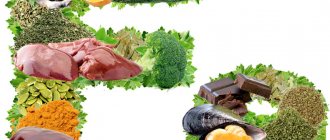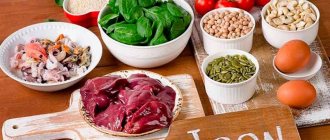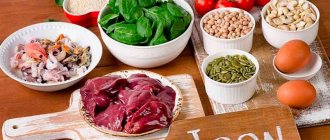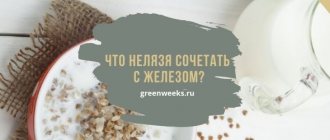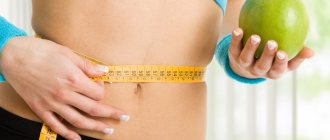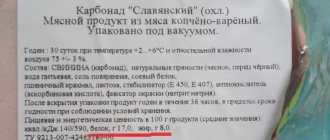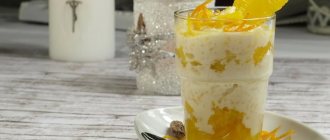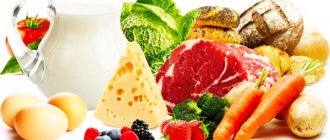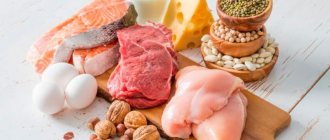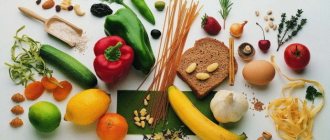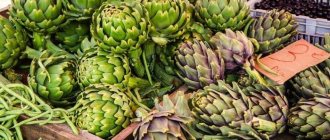June 25, 2021January 13, 2022
- The role of iron in the human body
- How much iron does a person need per day?
- Foods containing iron Fruits
- Vegetables
- Animal products
- Cereals
According to WHO, iron deficiency (Fe) is the main and most common nutritional disorder throughout the world: approximately 60% of the world's population does not have enough iron in the body, and 30% have such a lack of microelement that it manifests itself as anemia (anemia) []. As a rule, the reason lies in an unbalanced diet, poor in this microelement. And due to the enormous influence of the mineral on the body, its deficiency quickly affects health. From the article you will learn about the main causes of iron deficiency, what symptoms you need to pay attention to and what foods are rich in iron.
General rules
Iron is an essential trace element that is necessary for the normal functioning of all living organisms. Many processes occur with its participation: hormone , cell differentiation, metabolism .
It is part of respiratory enzymes and takes part in tissue respiration and redox reactions, and its presence in red blood cells ensures oxygen saturation of tissues. The main part of iron (about 65%) is found in hemoglobin and various depots (these include bone marrow, liver, spleen), then myoglobin , tissue enzymes and blood plasma follow in decreasing order of its content.
The need for iron depends on its losses and consumption. An adult man needs to consume 1 mg daily (or 13 mcg per kg of weight), and women need almost 1.5 times more - 21 mcg per kg of weight. In the last trimester of pregnancy , the need for it increases to 80 mcg per kg. The same amount is needed for an infant.
Entered with food, it is absorbed in the gastrointestinal tract. With sufficient nutrition, 10-20 mg is received daily, but only 2.5 mg is absorbed. This is due to several factors. First of all, food products contain ferric iron (oxidized), and only divalent iron is well absorbed. Partial transformation into an easily digestible divalent form occurs in the presence of ascorbic , succinic and pyruvic acid . In addition, iron absorption decreases after food is cooked, frozen, or stored.
A decrease in iron levels in the body leads to the development of iron deficiency conditions. First, stocks from the depot are consumed. With this disease, the level of iron in the blood, liver, bone marrow and spleen decreases. This entails a disruption in the formation of hemoglobin , red blood cells ( erythrocytes ) and tissue trophic (nutrition) disorders occur.
The causes of iron deficiency conditions are:
- Intensive growth (especially in the first year of life and in adolescence - the pubertal growth spurt), pregnancy and breastfeeding - all these conditions require an increased need for iron, since its consumption increases. If the deficiency is not replenished, anemia develops. From 2-3 years of age, the need for micronutrients decreases until adolescence, when rapid growth again raises the risk of deficiency. It is highest in young girls in whom the menstrual cycle is developing (11-14 years). In pregnant women, anemia develops in 20-80% of cases.
- Blood loss (for ulcers, injuries, malignant tumors, hemorrhoids , diaphragmatic hernia , esophageal varicose veins , diverticulosis , diseases of the respiratory tract and urinary organs, menorrhagia and metrorrhagia ).
- Long-term donation.
- Impaired absorption of iron during resection of the stomach or intestines, decreased gastric secretion, malabsorption syndrome .
- Taking anticoagulants, hormonal contraceptives, long-term use of antibiotics .
- Poor nutrition (such as vegetarianism or anorexia ).
- Excessive physical activity.
- Alcohol intoxication (chronic).
Early symptoms of iron deficiency (latent stage of anemia) do not cause concern in a person, and he considers himself healthy. In the future, in addition to weakness and increased fatigue, disorders of the endocrine, central nervous system and cardiovascular systems are noted. Exercise tolerance is significantly reduced. IDA causes complications in the mother and fetus: anomaly of labor, fetal hypoxia , delayed fetal development. Iron deficiency in young children leads to delayed psychomotor and emotional development.
Treatment should be comprehensive - medications and a diet rich in iron. Considering that iron from food is not completely absorbed, drug treatment is mandatory. Even a complete and balanced diet allows you to cover the physiological needs of the body, but does not eliminate its deficiency in anemia.
Taking iron supplements should be long-term and an improvement in hemoglobin and red blood cells does not indicate restoration of its reserves. Therefore, after normalization of Hb, the medication is continued for 1-2 months, but at half the dose. It should be remembered that almost all tablet drugs have an irritating effect on the gastrointestinal mucosa, causing pain, heartburn , diarrhea , nausea and even vomiting. Possible staining of tooth enamel black. Blood or red blood cell transfusion is used for health reasons (critical hemodynamic condition) in severe anemia.
The patient's nutrition must be complete. The diet contains an increased amount of protein (130-140 g), mostly of animal origin. Protein is necessary for the synthesis of hemoglobin , the construction of red blood cells and the formation of easily digestible iron compounds.
The amount of carbohydrates is within the physiological norm (up to 400 g). This includes complex carbohydrates (cereals, grain breads, muesli, fruits, legumes) and simple ones (sugar, honey, jam).
Since fats inhibit hematopoiesis, their quantity is limited (up to 70 g). They prefer easily digestible fats (all types of vegetable oils and butter). Animal fats, fatty meat and poultry, lard, and fatty sausages are subject to restrictions.
It is necessary to introduce into the diet an increased amount of vitamins that take part in erythropoiesis (group of B vitamins , ascorbic acid ). B vitamins are found in yeast (baker's and brewer's), legumes, liver, kidneys, egg yolks, meat, fish, milk, and cottage cheese. Folacin contains green lettuce, cabbage, green onions, soybeans.
Of course, an iron-containing diet must also include foods high in this microelement:
- meat (beef, rabbit, turkey, chicken);
- fish;
- beef tongue;
- liver (pork and beef);
- kidneys;
- heart;
- cottage cheese;
- chicken egg.
If we analyze food products containing iron, animal meat and poultry are sources of heme iron (only muscle tissue contains it) and its bioavailability is higher. In this regard, they should form the basis of the diet. If we compare animal products according to the content of this microelement, they are distributed (in descending order) as follows: beef tongue, rabbit meat, veal, beef, chicken egg, lamb, turkey, pork, chicken, cheese, cod, pink salmon, cottage cheese.
Iron in food products of plant origin (vegetables, legumes, cereals, tubers, fruits), as well as in milk and fish, is contained in non-heme form, the digestibility of which is much lower. In addition, tannins , soy protein, phosphates, dietary fiber and phytins form insoluble compounds with Fe.
Plant sources of iron include: asparagus, buckwheat, oat and millet cereals, grain bread, beets, sauerkraut, onions, fresh cabbage, zucchini, squash, green vegetables, mint, tops of plants and vegetables (radish, nettle, carrots, turnips) , mustard), dandelion leaves, watercress, apricots, apples, pears, oranges, pineapples, peaches, plums, strawberries, dried fruits, raspberries, strawberries, cherries, black currants.
Animal and poultry meat is a good source of heme iron with high bioavailability
Despite this, the diet should contain vegetables, herbs, and fruits, since they are the only sources of vitamin C , in the presence of which the absorption of this microelement in the duodenum improves (it restores iron and forms well-absorbed chelate complexes with it). It is necessary to eat all green leafy vegetables, citrus fruits, sea buckthorn, rose hips, plums, black currants, all sour berries, pears, apples, all types of cabbage, including sauerkraut, carrots, beets, lettuce peppers, pumpkin, tomatoes.
Promote iron absorption and normalize the process of hematopoiesis:
- B vitamins - folic acid and cyanocobalamin - play a great role in hematopoiesis and their deficiency leads to disruption of DNA synthesis in stem cells, and this negatively affects the rate of hemoglobin synthesis. Sources of folic acid (lettuce, spinach, green onions, parsley, lentils, beans, beans, all types of cabbage, asparagus, citrus fruits, pears, apples, apricots, bananas, kiwi, pomegranate, currants, strawberries, grapes, raspberries) must be present in the diet. Suppliers of cyanocobalamin are: animal liver, meat, fish, caviar, fermented milk products, raw chicken egg yolk, yeast, salads, green onions, vegetable tops.
- Copper, which contains liver, cereals, legumes, mushrooms, nuts, raw yolk, strawberries, black currants, watermelons, horseradish, asparagus, beef, wheat sprouts, barley, asparagus, lentils, parsley, rye bread, kefir, yogurt.
- Succinic acid , found in fermented milk products, sunflower oil, sunflower seeds, barley, rye bread, gooseberries (green varieties), apples, cherries, grapes.
- Zinc, which can be obtained by eating yeast, liver, kidneys, legumes, mushrooms, beef, cheeses, eggs. The presence of an additive effect of zinc and iron justifies the need for use during pregnancy.
- Cobalt contains: liver, legumes, kidneys, grains, salad greens, beets, pumpkin, green vegetables, gooseberries, raspberries, apples, black currants, apricots, cherries, pears, nuts, citrus fruits, mushrooms.
- Sulfur-containing foods: onions, garlic and all types of cabbage.
- Spicy herbs - thyme, mint, cinnamon, anise, which can be used to season all dishes.
- “Animal protein factor” - protein increases the absorption of micronutrients and contains myoglobin and hemoglobin.
- Simple carbohydrates (fructose, lactose, sorbitol).
- Amino acids ( histidine , lysine , cysteine ) form easily absorbed chelates.
It is also necessary to take into account antagonistic products that impair the absorption of iron and form insoluble salts with its trivalent form. Such products include:
- Tannin-containing - the main content of tannin in coffee and tea.
- Chocolate.
- Phytin-containing foods (whole grains, rice, soy flour, legumes, bran, walnuts). Soaking cereals, legumes and nuts significantly reduces the phytic acid content;
- Polyphenols of nuts, legumes, tea.
- Oxalates (chocolate, grains, corn, spinach, sorrel, milk, tea).
- Foods high in calcium: sesame, milk, cottage cheese, dried fruits. Calcium can reduce the absorption of heme and non-heme iron.
- Eggs because they contain albumin and phosphoprotein .
- Cereals due to their dietary fiber and phytate . Dietary fiber in the intestines is almost not digested, and iron is fixed on it and excreted in feces.
Alcoholic drinks destroy iron in foods that are consumed with them. Heme iron has a relatively high heat stability, and foods with the non-heme form are not recommended for heat treatment. Meat, liver and fish, with the simultaneous use of vegetables and fruits, increase the absorption of iron from them.
Understanding nutrition labels
Figure 1. Iron content on nutrition labels
To maintain normal iron levels, eat foods rich in iron. The iron content of foods is listed on the nutrition label (see Figure 1). Nutrition labels list the amount of iron as a percentage (%) of the daily intake. The daily intake of iron is 18 mg.
- If the percentage of daily intake is 5% or less, the product is considered a poor source of iron.
- If the share of consumption of the daily value is 10-19%, it is considered that such a product is a good source of iron.
- If the proportion of intake of the daily value is 20% or higher, the product is considered to have a high iron content.
You can accurately calculate the amount of iron in a product. To do this, multiply the daily intake of iron (18 mg) by the percentage of the daily intake in 1 serving of the product. For example, if the nutrition label states that a food contains 50% of the DV for iron, then multiply 18 mg by 50% (0.5). Multiplying 18 by 0.5 equals 9. This means that one serving of this product contains 9 mg of iron.
The daily iron intake in the Recommended Daily Iron Intake table is provided as a guideline. You may need more or less of it. Check with your healthcare provider to find out how much iron you need each day.
to come back to the beginning
Authorized Products
An iron-containing diet should include:
- Meat, poultry, fish and offal of various culinary preparations, but preference is given to steaming, baking and boiling. Foods prepared in this form are easier to digest and absorb. As for consuming liver, it does contain a lot of vitamins and microelements, but iron is bound by proteins and is not readily available when consuming it. Beef tongue contains more iron, then beef and pork, chicken and rabbit (they contain 8-10 mcg).
- Soups based on broths with the addition of meat. It is known that meat/fish/mushroom broths stimulate appetite, which is often reduced in anemia. To improve appetite, you can eat sauces and salt food, season dishes with pepper, onions, garlic and other spices.
- Cereals - buckwheat, oatmeal, millet in the form of porridges on water and legumes.
- Vegetables - tomatoes, beets, potatoes, greens, carrots, cauliflower, broccoli, sauerkraut, fresh cabbage, bell peppers, pumpkin, asparagus, onions, zucchini, squash and other green vegetables, watercress. In early spring, it is useful to add tops of plants and vegetables (radish, nettle, carrots, turnips, mustard) and dandelion leaves to salads. For better absorption, flavor with vegetable oils.
- Fruits - apple, pomegranate, pear, persimmon, currant, plums, apricots, quince, citrus fruits, blueberries, strawberries, strawberries, peaches, apricots, oranges, pineapples, raspberries, cherries. You need to eat raisins, prunes, and fruit juices.
- Wheat and rye bread.
- Fermented milk drinks, since they contain lactic acid, which, like all organic acids, promotes better absorption of the microelement.
- Eggs.
- Butter and various vegetable oils.
- Drinks: juices (tomato, carrot, beet, peach, apple, apricot), cocoa, rosehip infusion, wheat bran decoction. Fruit drinks and juices that are rich in ascorbic, malic, succinic and other organic acids. And they significantly contribute to the absorption of iron in the intestines. Tea lovers should drink it 2 hours before or after meals and medications.
- Sugar, jam, honey jam.
Table of permitted products
| Proteins, g | Fats, g | Carbohydrates, g | Calories, kcal | |
Vegetables and greens | ||||
| spicy vegetables | 2,8 | 0,5 | 5,3 | 36 |
| greenery | 2,6 | 0,4 | 5,2 | 36 |
| eggplant | 1,2 | 0,1 | 4,5 | 24 |
| zucchini | 0,6 | 0,3 | 4,6 | 24 |
| cabbage | 1,8 | 0,1 | 4,7 | 27 |
| sauerkraut | 1,8 | 0,1 | 4,4 | 19 |
| potato | 2,0 | 0,4 | 18,1 | 80 |
| nettle | 2,6 | 0,3 | 5,2 | 33 |
| watercress | 2,3 | 0,1 | 1,3 | 11 |
| green onion | 1,3 | 0,0 | 4,6 | 19 |
| bulb onions | 1,4 | 0,0 | 10,4 | 41 |
| carrot tops | 0,6 | 0,1 | 5,3 | 35 |
| carrot | 1,3 | 0,1 | 6,9 | 32 |
| dandelion | 2,7 | 0,7 | 6,7 | 45 |
| beet | 1,5 | 0,1 | 8,8 | 40 |
| beet tops | 2,1 | 0,5 | 5,5 | 17 |
| asparagus | 1,9 | 0,1 | 3,1 | 20 |
| pumpkin | 1,3 | 0,3 | 7,7 | 28 |
| garlic | 6,5 | 0,5 | 29,9 | 143 |
Fruits | ||||
| apricots | 0,9 | 0,1 | 10,8 | 41 |
| oranges | 0,9 | 0,2 | 8,1 | 36 |
| watermelon | 0,6 | 0,1 | 5,8 | 25 |
| bananas | 1,5 | 0,2 | 21,8 | 95 |
| cherry | 0,8 | 0,5 | 11,3 | 52 |
| pears | 0,4 | 0,3 | 10,9 | 42 |
| figs | 0,7 | 0,2 | 13,7 | 49 |
| lemons | 0,9 | 0,1 | 3,0 | 16 |
| tangerines | 0,8 | 0,2 | 7,5 | 33 |
| plums | 0,8 | 0,3 | 9,6 | 42 |
| apples | 0,4 | 0,4 | 9,8 | 47 |
Berries | ||||
| hawthorn | 0,0 | 0,0 | 14,0 | 52 |
| grape | 0,6 | 0,2 | 16,8 | 65 |
| blackberry | 2,0 | 0,0 | 6,4 | 31 |
| irga | 0,0 | 0,0 | 12,0 | 45 |
| viburnum | 0,0 | 0,0 | 7,0 | 26 |
| strawberry | 0,8 | 0,4 | 7,5 | 41 |
| cranberry | 0,5 | 0,0 | 6,8 | 26 |
| raspberries | 0,8 | 0,5 | 8,3 | 46 |
| sea buckthorn | 1,2 | 5,4 | 5,7 | 82 |
| black currant | 1,0 | 0,4 | 7,3 | 44 |
| chokeberry | 1,5 | 0,2 | 10,9 | 55 |
Mushrooms | ||||
| mushrooms | 3,5 | 2,0 | 2,5 | 30 |
Nuts and dried fruits | ||||
| raisin | 2,9 | 0,6 | 66,0 | 264 |
| dried apricots | 5,2 | 0,3 | 51,0 | 215 |
| dried apricots | 5,0 | 0,4 | 50,6 | 213 |
| dates | 2,5 | 0,5 | 69,2 | 274 |
Cereals and porridges | ||||
| buckwheat (kernel) | 12,6 | 3,3 | 62,1 | 313 |
| cereals | 11,9 | 7,2 | 69,3 | 366 |
| millet cereal | 11,5 | 3,3 | 69,3 | 348 |
Confectionery | ||||
| jam | 0,3 | 0,2 | 63,0 | 263 |
| jelly | 2,7 | 0,0 | 17,9 | 79 |
| marshmallows | 0,8 | 0,0 | 78,5 | 304 |
| fruit and berry marmalade | 0,4 | 0,0 | 76,6 | 293 |
| paste | 0,5 | 0,0 | 80,8 | 310 |
Raw materials and seasonings | ||||
| honey | 0,8 | 0,0 | 81,5 | 329 |
| sugar | 0,0 | 0,0 | 99,7 | 398 |
Dairy | ||||
| milk | 3,2 | 3,6 | 4,8 | 64 |
| kefir | 3,4 | 2,0 | 4,7 | 51 |
| sour cream | 2,8 | 20,0 | 3,2 | 206 |
| curdled milk | 2,9 | 2,5 | 4,1 | 53 |
| acidophilus | 2,8 | 3,2 | 3,8 | 57 |
| yogurt | 4,3 | 2,0 | 6,2 | 60 |
Cheeses and cottage cheese | ||||
| cottage cheese | 17,2 | 5,0 | 1,8 | 121 |
Meat products | ||||
| beef | 18,9 | 19,4 | 0,0 | 187 |
| veal | 19,7 | 1,2 | 0,0 | 90 |
| rabbit | 21,0 | 8,0 | 0,0 | 156 |
Bird | ||||
| chicken | 16,0 | 14,0 | 0,0 | 190 |
| turkey | 19,2 | 0,7 | 0,0 | 84 |
Eggs | ||||
| chicken eggs | 12,7 | 10,9 | 0,7 | 157 |
Fish and seafood | ||||
| black caviar | 28,0 | 9,7 | 0,0 | 203 |
| salmon caviar granular | 32,0 | 15,0 | 0,0 | 263 |
| punched pollock caviar | 28,4 | 1,9 | 0,0 | 131 |
Oils and fats | ||||
| corn oil | 0,0 | 99,9 | 0,0 | 899 |
| olive oil | 0,0 | 99,8 | 0,0 | 898 |
| sunflower oil | 0,0 | 99,9 | 0,0 | 899 |
Non-alcoholic drinks | ||||
| mineral water | 0,0 | 0,0 | 0,0 | — |
| lingonberry juice | 0,1 | 0,0 | 10,7 | 41 |
| green tea | 0,0 | 0,0 | 0,0 | — |
Juices and compotes | ||||
| apricot juice | 0,9 | 0,1 | 9,0 | 38 |
| carrot juice | 1,1 | 0,1 | 6,4 | 28 |
| pumpkin juice | 0,0 | 0,0 | 9,0 | 38 |
| * data is per 100 g of product | ||||
Seafood
They all contain high amounts of iron, especially shrimp, oysters and mussels. Thus, a 100-gram serving of seafood can contain 17% of the daily value of the mineral. It is important to remember that the iron found in shellfish (heme iron) is more easily absorbed by the body than that found in vegetables. Seafood also increases the level of “good cholesterol,” which is good for the health of the heart and blood vessels.
Fully or partially limited products
Excludes:
- Fatty meat and poultry.
- Refractory fats.
- Sausages, smoked meats, canned food.
Limit consumption or consume following certain recommendations:
- Tea as a tannin-containing drink and coffee containing polyphenols. You should not drink them during meals or immediately after them - take a break of 1.5-2 hours.
- Don't go overboard with nuts and legumes due to their polyphenol .
- Eggs because they contain albumin and phosphoprotein .
- Whole grain cereals, rice, soy flour, legumes, baked goods, bran, walnuts due to the content of dietary fiber and phytic acid . Dietary fiber in the intestines is almost not digested, and iron is fixed on them and excreted in feces. Phytic acid reduces the absorption of many microelements, including this one. Based on this, meat and fish should be eaten separately from bread, cereals and pasta.
- Products with a high content of oxalic acid , which interferes with the complete absorption of the microelement, are spinach, sorrel, beets, asparagus, rhubarb, nuts, chocolate, corn.
- Products high in calcium: sesame, milk, cottage cheese, cheeses, dried fruits; calcium can reduce the absorption of heme and non-heme iron.
Table of prohibited products
| Proteins, g | Fats, g | Carbohydrates, g | Calories, kcal | |
Vegetables and greens | ||||
| vegetables legumes | 9,1 | 1,6 | 27,0 | 168 |
| canned vegetables | 1,5 | 0,2 | 5,5 | 30 |
| swede | 1,2 | 0,1 | 7,7 | 37 |
| canned cucumbers | 2,8 | 0,0 | 1,3 | 16 |
| radish | 1,2 | 0,1 | 3,4 | 19 |
| white radish | 1,4 | 0,0 | 4,1 | 21 |
| canned tomatoes | 1,1 | 0,1 | 3,5 | 20 |
| horseradish | 3,2 | 0,4 | 10,5 | 56 |
Cereals and porridges | ||||
| corn grits | 8,3 | 1,2 | 75,0 | 337 |
| white rice | 6,7 | 0,7 | 78,9 | 344 |
Confectionery | ||||
| candies | 4,3 | 19,8 | 67,5 | 453 |
| cookie | 7,5 | 11,8 | 74,9 | 417 |
| cake | 3,8 | 22,6 | 47,0 | 397 |
Raw materials and seasonings | ||||
| mustard | 5,7 | 6,4 | 22,0 | 162 |
| ketchup | 1,8 | 1,0 | 22,2 | 93 |
| mayonnaise | 2,4 | 67,0 | 3,9 | 627 |
| ground black pepper | 10,4 | 3,3 | 38,7 | 251 |
| vinegar | 0,0 | 0,0 | 5,0 | 20 |
Bird | ||||
| smoked chicken | 27,5 | 8,2 | 0,0 | 184 |
| duck | 16,5 | 61,2 | 0,0 | 346 |
| smoked duck | 19,0 | 28,4 | 0,0 | 337 |
| goose | 16,1 | 33,3 | 0,0 | 364 |
Fish and seafood | ||||
| smoked fish | 26,8 | 9,9 | 0,0 | 196 |
Oils and fats | ||||
| creamy margarine | 0,5 | 82,0 | 0,0 | 745 |
| animal fat | 0,0 | 99,7 | 0,0 | 897 |
| cooking fat | 0,0 | 99,7 | 0,0 | 897 |
Non-alcoholic drinks | ||||
| coffee | 0,2 | 0,0 | 0,3 | 2 |
| green tea | 0,0 | 0,0 | 0,0 | — |
| black tea | 20,0 | 5,1 | 6,9 | 152 |
| * data is per 100 g of product | ||||
Daily iron intake
Experts at the Institute of Medicine recommend consuming a certain amount of iron depending on age and gender. These recommendations are listed below in the Recommended Daily Allowance for Iron table. Iron is measured in milligrams (mg).
Recommended daily intake of iron | ||
| Age | Men | Women |
| 7–12 months | 11 mg | 11 mg |
| 1–3 years | 7 mg | 7 mg |
| 4–8 years | 10 mg | 10 mg |
| 9–13 years | 8 mg | 8 mg |
| 14–18 years old | 11 mg | 15 mg |
| 19–50 years old | 8 mg | 18 mg |
| 51 years and older | 8 mg | 8 mg |
to come back to the beginning
Menu (Power Mode)
The range of products is varied, as there are no significant restrictions. Nutrition should be complete and high in calories. You can consume gray and black bread up to 300 g per day, butter and vegetable oil up to 30 g.
Breakfast should be complete and must contain a protein dish (boiled meat, fried or stewed liver, eggs, cutlet, fish) with a side dish of cereals or vegetables. Weak tea with milk, cheese, bread, butter and honey.
The second breakfast includes cheese, fish of any method of preparation, stewed or raw vegetables, milk or rosehip infusion, any juice.
At lunch, the first courses should be cooked in meat, chicken or fish broth with a piece of meat, fish or meatballs. Second courses are also protein (stew, liver, meat or fish cutlets, turkey, rabbit) with vegetable or cereal side dishes, vegetable salads. You can prepare compotes from dried and fresh fruits, juices, and jelly.
The afternoon snack includes cottage cheese dishes, fresh fruits or berries (you can make mousses and jellies from them), tea with milk.
Dinner should also contain two courses. This can include meat and fish dishes with your favorite side dish and cottage cheese casserole with jam and milk.
At night - a fermented milk drink of your choice: kefir, yogurt, yogurt, acidophilus, fermented baked milk.
Currant
Fruits are not the best source of iron, but there are exceptions. For example, black currant. With 100 grams of berries, our body will receive 12% of the daily requirement of a useful mineral. Currants also contain vitamin C, which, as we already know, promotes the absorption of iron in the body. You should also pay attention to mulberries, persimmons, blueberries, and elderberries.
Reviews and results
This food is complete and varied in composition, contains an increased amount of protein - the patient receives protein products 5 times a day (including kefir or milk at night). Reviews often contain messages from patients who have suffered severe pneumonia or surgery and who were prescribed this diet.
- “... After several operations, hemoglobin decreased. It is clear that good protein nutrition was needed. Already at the hospital they began to bring rabbit, boiled beef tongue, red and black caviar, liver pate with egg yolks, freshly squeezed pomegranate juice, and persimmon. At home, she continued to eat heavily, plus she ate a mixture of nuts, dates, raisins, prunes with the addition of one lemon along with the peel and 2 tablespoons of honey. I put everything through a meat grinder and ate a tablespoon 2 times a day. After a month I began to feel more cheerful”;
- “... I had severe anemia - we even thought about a blood transfusion, but I managed with medication and increased nutrition. At that time, I fainted every other day, my skin and hair were in terrible condition. Hemobin is an excellent remedy - it returned to normal in 3 weeks, but I was told to take it for another month. As for nutrition, the doctor focused more on red meat and seafood than on vegetables and fruits. I ate intensely for 2 months, the main products were: liver, rare steaks from red meat, cranberry juice, shellfish and oysters (but very expensive) and, oddly enough, chokeberry, mashed with sugar, helped very well.”
- “... I didn’t know about anemia before pregnancy. Terrible weakness and drowsiness began to plague me from the second month. I noticed that cracks began to appear in the corners of my mouth and my nails were breaking. There was no toxicosis, and there was a normal appetite. They checked my hemoglobin and immediately prescribed the drug Ferlatum plus food: more meat, liver, they bought black caviar, tongue, rabbit and turkey for me. I tried not to cook them too much to preserve all the vitamins. I ate a lot of persimmons and pomegranates, drank carrot and beet juice, but they were so caustic, so after a week I started feeling discomfort in my stomach.”
Iron-deficiency anemia
If your body doesn't get enough iron, you may develop a disease called iron deficiency anemia. This may happen if:
- your diet lacks iron;
- you have recently undergone chemotherapy or radiotherapy;
- you have chronic (long-term) diseases;
- you have lost some blood (for example, due to heavy menstrual bleeding, an accident, or during surgery).
Iron supplements
If you have low iron levels, your healthcare provider may prescribe an iron supplement. Taking iron supplements will help normalize your iron levels quickly. The amount of iron your healthcare provider recommends you take may be higher than the amount listed in the Recommended Daily Allowance for Iron table.
Taking too much iron can cause stomach upset and constipation (when you have fewer bowel movements than usual). Tell your healthcare professional if you experience these or any other problems while taking iron. Do not take any supplements without first consulting a healthcare professional.
to come back to the beginning
Shellfish
Shellfish, including oysters, clams, and mussels, are concentrated sources of minerals and contain selenium, zinc, copper, and iron (6).
Consuming 6 medium-sized oysters (84 grams) meets your daily requirements for zinc and copper and provides 30% and 22% of the RDA for selenium and iron, respectively (7).
Zinc is a nutrient essential for immune function, DNA production, cell division, and protein production (6).
Pregnant and breastfeeding women, people with gastrointestinal diseases, people taking certain medications, teenagers, and the elderly are populations at risk of zinc deficiency, which can impair the immune response, interfere with growth and development, and increase the risk of infections (8) .
Shellfish are a concentrated source of zinc and are a smart choice for those at risk of becoming deficient in this vital nutrient.
Excess copper
An overdose of copper is possible only with the abuse of synthetic dietary supplements. Natural sources of microelements provide adequate concentrations of the substance necessary to maintain body functions.
The body can signal excess copper in different ways. Usually an overdose of Cu is accompanied by:
- hair loss;
- the appearance of early wrinkles;
- sleep disorders;
- disruptions of the menstrual cycle in women;
- fevers and profuse sweating;
- convulsions.
In addition, the toxic effects of copper on the body can cause kidney failure or gastroenteritis. There is a risk of epileptic seizures and mental impairment. The most serious consequence of copper poisoning is Wilson's disease (copper disease).
At the “biochemistry” level, an overdose of copper displaces zinc, manganese and molybdenum from the body.
Black chocolate
30 grams of dark chocolate is a source of various beneficial substances. For example, antioxidants, magnesium, copper and, of course, iron, as well as fiber that improves intestinal function. Research by American scientists has shown that chocolate lowers cholesterol and improves heart health. But the benefits of this product depend on the content of cocoa beans in it. Only dark chocolate containing at least 70% cocoa beans should be included in your diet.
Starchy vegetables
Starchy vegetables such as sweet potatoes, potatoes and parsnips are a great alternative to refined carbohydrates such as white rice and pasta. Starchy vegetables are highly nutritious and contain fiber, as well as antioxidants, vitamins, and minerals (36, 37).
Many people avoid starchy vegetables due to their high carbohydrate content. However, starchy vegetables are an important source of nutrients, including minerals such as potassium, magnesium, manganese, calcium, iron, and copper (38).
Eggs
Eggs are often called nature's multivitamins—and for good reason. Whole eggs are rich in nutrients and contain many important minerals.
They're high in iron, phosphorus, zinc, and selenium, as well as high in vitamins, healthy fats, antioxidants, and protein (15).
Although the cholesterol in egg yolks causes many people to avoid eating them, yolks contain almost all the vitamins, minerals, and other beneficial compounds, so it's recommended to eat the whole egg, not just the white (16, 17).
Silicon
Despite the fact that silicon is present in the blood in fairly small quantities, when its reserves decrease, a person begins to react sharply to weather changes (this can include mood swings, severe headaches, and a deterioration in mental state). In addition, a deficiency of this element negatively affects the condition of the skin, hair and teeth.
© onlyfabrizio
The benefits of silicon
- Ensuring calcium metabolism.
- Preserving the strength of teeth.
- Promoting the elasticity of vascular walls, tendons, muscles.
- Strengthening hair.
- Reduced development of skin diseases.
- Normalization of the nervous system.
- Improving heart function.
- Ensuring normal bone growth.
- Enhanced calcium absorption.
- Improved brain functioning.
- Normalization of metabolism.
- Stimulation of immunity.
- Reduced blood pressure.
- Strengthening connective tissue.
- Slowing down the aging process.
Excess silicon in the body is caused by occupational hazards of workers involved in industrial enterprises working with cement, glass, and asbestos.
What foods contain silicon?
The daily requirement of silicon, which is fully satisfied through a balanced diet, is 20 – 50 mg. However, in the presence of osteoporosis, cardiovascular diseases, as well as Alzheimer's disease, it is necessary to increase the consumption of foods containing this trace element.
© zstockphotos
Food sources of silicon:
- rice;
- oats;
- barley;
- soy;
- legumes;
- buckwheat;
- pasta;
- corn;
- Wheat flour;
- cereals;
- nuts;
- grape;
- eggs;
- fish caviar;
- mineral water;
- green vegetables;
- Jerusalem artichoke;
- potato;
- bulb onions;
- seafood;
- radish;
- seaweed;
- dairy products;
- beet;
- bell pepper;
- seeds;
- meat and offal;
- mushrooms;
- carrot;
- berries;
- apricots;
- bananas;
- cherry;
- dried fruits.
In addition, silicon is found in grape juice, wine and beer.
Selenium
Selenium is one of the few substances that can prevent the development of cancer. This microelement prevents cell mutations and restores damage already caused to them.
© Molekuul/Getty Images
Benefits of selenium
- Increasing the body's resistance to viruses and bacteria.
- Neutralization of toxins and free radicals.
- Enhances powerful antioxidants such as vitamins E and C.
- Prevention of premature aging.
- Stimulation of hemoglobin synthesis.
- Stimulation of metabolic processes.
- Stimulation of reproductive function.
- Normalization of the nervous and endocrine systems.
- Improving the condition of skin, nails, hair.
- Elimination of inflammatory processes.
Interesting fact!
Previously, selenium was classified as a toxic substance, which undoubtedly has a rational grain. The fact is that in large doses (about 5 mg) selenium actually has a toxic effect on the body, while a deficiency of this element (less than 5 mcg) leads to the development of serious diseases and premature aging.
It should be noted that selenium deficiency is extremely rare, manifesting mainly in general weakness and muscle pain.
An excess of selenium is caused by taking inorganic forms of this element, which are included in the composition of drugs. Signs of excess selenium are:
- peeling of the skin;
- hair loss;
- peeling of nails;
- tooth decay;
- development of nervous disorders.
What foods contain selenium?
Important!
Vitamin E improves the absorption of selenium. But sugar, carbonated drinks and confectionery products interfere with the absorption of this substance.
© Artemidovna/Getty Images
Food sources of selenium:
- olive oil;
- animal kidneys and liver;
- fish;
- seafood;
- broccoli;
- nuts;
- cereals;
- mushrooms;
- legumes;
- corn;
- milk;
- Brewer's yeast;
- sour cream;
- garlic;
- olives;
- sprouted wheat grains;
- coconut;
- salted lard;
- sea salt.
Bor
This microelement is present throughout our body, but its maximum concentration is observed in tooth enamel, as well as in bones.
© AndreyPopov / Getty Images Pro
Benefits of boron
- Relieving inflammation.
- Normalization of fat metabolism.
- Normalization of the functioning of the endocrine glands.
- Strengthening and improving the skeletal structure.
- Preventing the development of kidney stones by reducing the amount of oxalates in the urine.
- Normalization of hormonal metabolism.
- Regulation of reproduction processes.
- Stimulation of antiviral immunity.
According to the results of studies, the risk of developing boron deficiency is practically zero, since about 1–3 mg of this element enters the body daily with food, water and air, which corresponds to the norm.
Important!
Boron is a potent toxic substance, therefore, when there is an excess of it in the body, irreversible changes begin, leading to diseases of the liver, nervous system and gastrointestinal tract. Most often, an excess of this element in the body is caused by improper use of vitamin complexes, in which boron is present in a poorly digestible form. For this reason, both doctors and nutritionists recommend getting this trace element from food.
What foods contain boron?
As mentioned above, the daily requirement for boron is 1–3 mg, while it is enough to receive 0.2 mg of this microelement per day to eliminate its deficiency.
© welcomia
Food sources with boron:
- mineral water;
- soy;
- legumes;
- nuts;
- grape;
- beet;
- corn;
- apples;
- cereals;
- cabbage of different varieties;
- seaweed;
- onion;
- carrot;
- seafood;
- prunes;
- pears;
- tomatoes;
- dates;
- raisin;
- honey;
- milk;
- meat;
- fish;
- beer;
- red wine.
